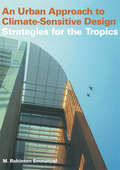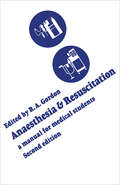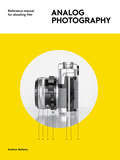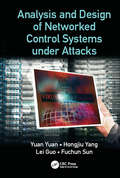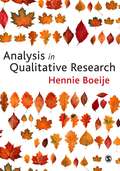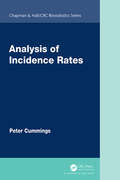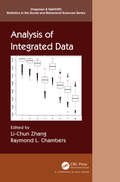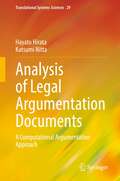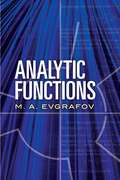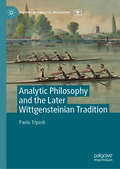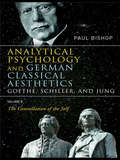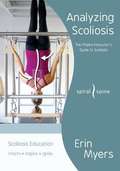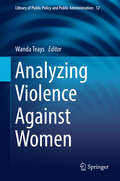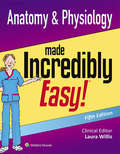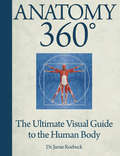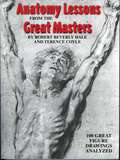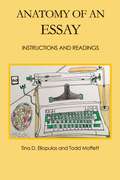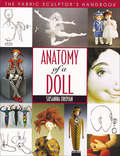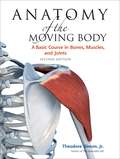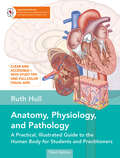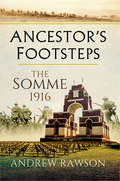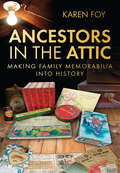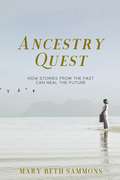- Table View
- List View
An Urban Approach To Climate Sensitive Design: Strategies for the Tropics
by Rohinton EmmanuelThe need to respond to the rapidly changing city climate is particularly urgent in the tropics where the urban transition is currently at its peak. While the need is clearly felt by the tropical urban dwellers, texts that provide an overview of the problem and indicate possible design solutions are rare. This comprehensive reference will be welcomed by student and practising architects as well as other built envronment professionals engaged with the environmental effects of building in worldwide warm and humid climates.
Anaesthesia and Resuscitation: A manual for medical students (Second edition)
by Roderick A. GordonAs in most fields of medical practice many things in anaesthesia are done on an empirical basis: this speciality is dynamic and expanding, and today's dogma may become tomorrow's error. This introductory manual, now revised and updated in a second edition, was prepared by the Department of Anaesthesia in Canadian medical schools and provides the undergraduate medical student with an important foundation for wider knowledge in the realm of anaesthesiology. Contents include Anaesthesia in relation to surgery , Evaluation of the patient before anaesthesia, Preanaesthetic medication, General anaesthesia, Neuromuscular transmission and muscle relaxation, Regional anaesthesia, Care of the unconscious patient, Respiration and anaesthesia, Cardiovascular homeostasis in relation to anaesthesia and resuscitation, Fluid and electrolyte balance, Acid-base balance, Complications of anaesthesia, Postoperative problems and care, Obstetrical anaesthesia and resuscitation of the newborn, and Special considerations in paediatric anaesthesia.
Analog Photography: Reference Manual for Shooting Film
by Andrew BellamyAttracted by the image quality, the tactile joy of a finely made camera, and the affordable prices of vintage equipment, photographers around the world are rediscovering the joys of manual photography. This comprehensive guide to shooting film photography covers all the bases, from setting up a camera through film processing. In a convenient format, filled with diagrams, examples, and illustrations, Analog Photography is a portable reference tool for neophytes and experienced photographers alike. With an irresistible package inspired by the aesthetics of vintage user manuals, this is "a great-looking publication and a fantastic place from which to start, or rekindle, a journey into film photography" (Creative Review).
Analysis Of Engineering Design Studies For Demilitarization Of Assembled Chemical Weapons At Blue Grass Army Depot
by National Research Council of the National AcademiesThe Program Manager for Assembled Chemical Weapons Assessment (PMACWA) of the Department of Defense (DOD) requested the National Research Council (NRC) to assess the engineering design studies (EDSs) developed by Parsons/Honeywell and General Atomics for a chemical demilitarization facility to completely dispose of the assembled chemical weapons at the Pueblo Chemical Depot in Pueblo, Colorado. To accomplish the task, the NRC formed the Committee on Review and Evaluation of Alternative Technologies for Demilitarization of Assembled Chemical Weapons: Phase II (ACW II Committee). This report presents the results of the committee's scientific and technical assessment, which will assist the Office of the Secretary of Defense in selecting the technology package for destroying the chemical munitions at Pueblo.
Analysis and Design of Networked Control Systems under Attacks
by Fuchun Sun Yuan Yuan Hongjiu Yang Lei GuoThis book adopts a systematic view of the control systems in cyber-physical systems including the security control of the optimal control system, security control of the non-cooperative game system, quantify the impact of the Denial-of-Service attacks on the optimal control system, and the adaptive security control of the networked control systems. Because the cyber-physical system is a hybrid system, it adopts cross layer approach to handle the security control of the CPS. It presents a number of attack models according to the attack scenario and defense facilities, and a number of cross-layer co-design methodologies to secure the control of CPS.
Analysis in Qualitative Research
by Hennie BoeijeWritten for anyone beginning a research project, this introductory book takes you through the process of analysing your data from start to finish. The author sets out an easy-to-use model for coding data in order to break it down into parts, and then to reassemble it to create a meaningful picture of the phenomenon under study. Full of useful advice, the book guides the reader through the last difficult integrating phase of qualitative analysis including diagramming, memoing, thinking aloud, and using one's feelings, and how to incorporate the use of software where appropriate. Ideal for third year undergraduate students, master students, postgraduates and anybody beginning a research project, the book includes examples covering a wide range of subjects - making the book useful for students across the social science disciplines. Hennie Boeije is currently an Associate Professor with the Department of Methodology and Statistics of the Faculty of Social and Behavioural Sciences at Utrecht University, The Netherlands.
Analysis of Cancer Risks in Populations Near Nuclear Facilities: Phase 2 Pilot Planning
by Committee on the Analysis of Cancer Risks in Populations Near Nuclear Facilities-Phase 2 Pilot PlanningAnalysis of Cancer Risks in Populations near Nuclear Facilities is a pilot study requested by the United States Nuclear Regulatory Commission (USNRC) to assess the risk of cancer near nuclear facilities in the United States.<P><P> This effort is being carried out in two phases. The Phase 1 study recommended two study designs appropriate for assessing cancer risks near nuclear facilities. It also recommended a pilot study of seven nuclear facilities to assess the technical feasibility of the recommended study designs. The Phase 2 study is the assessment of cancer risks.
Analysis of Incidence Rates (Chapman & Hall/CRC Biostatistics Series)
by Peter CummingsIncidence rates are counts divided by person-time; mortality rates are a well-known example. Analysis of Incidence Rates offers a detailed discussion of the practical aspects of analyzing incidence rates. Important pitfalls and areas of controversy are discussed. The text is aimed at graduate students, researchers, and analysts in the disciplines of epidemiology, biostatistics, social sciences, economics, and psychology. Features: Compares and contrasts incidence rates with risks, odds, and hazards. Shows stratified methods, including standardization, inverse-variance weighting, and Mantel-Haenszel methods Describes Poisson regression methods for adjusted rate ratios and rate differences. Examines linear regression for rate differences with an emphasis on common problems. Gives methods for correcting confidence intervals. Illustrates problems related to collapsibility. Explores extensions of count models for rates, including negative binomial regression, methods for clustered data, and the analysis of longitudinal data. Also, reviews controversies and limitations. Presents matched cohort methods in detail. Gives marginal methods for converting adjusted rate ratios to rate differences, and vice versa. Demonstrates instrumental variable methods. Compares Poisson regression with the Cox proportional hazards model. Also, introduces Royston-Parmar models. All data and analyses are in online Stata files which readers can download. Peter Cummings is Professor Emeritus, Department of Epidemiology, School of Public Health, University of Washington, Seattle WA. His research was primarily in the field of injuries. He used matched cohort methods to estimate how the use of seat belts and presence of airbags were related to death in a traffic crash. He is author or co-author of over 100 peer-reviewed articles.
Analysis of Integrated Data (Chapman & Hall/CRC Statistics in the Social and Behavioral Sciences)
by Li-Chun Zhang and Raymond L. ChambersThe advent of "Big Data" has brought with it a rapid diversification of data sources, requiring analysis that accounts for the fact that these data have often been generated and recorded for different reasons. Data integration involves combining data residing in different sources to enable statistical inference, or to generate new statistical data for purposes that cannot be served by each source on its own. This can yield significant gains for scientific as well as commercial investigations. However, valid analysis of such data should allow for the additional uncertainty due to entity ambiguity, whenever it is not possible to state with certainty that the integrated source is the target population of interest. Analysis of Integrated Data aims to provide a solid theoretical basis for this statistical analysis in three generic settings of entity ambiguity: statistical analysis of linked datasets that may contain linkage errors; datasets created by a data fusion process, where joint statistical information is simulated using the information in marginal data from non-overlapping sources; and estimation of target population size when target units are either partially or erroneously covered in each source. Covers a range of topics under an overarching perspective of data integration. Focuses on statistical uncertainty and inference issues arising from entity ambiguity. Features state of the art methods for analysis of integrated data. Identifies the important themes that will define future research and teaching in the statistical analysis of integrated data. Analysis of Integrated Data is aimed primarily at researchers and methodologists interested in statistical methods for data from multiple sources, with a focus on data analysts in the social sciences, and in the public and private sectors.
Analysis of Legal Argumentation Documents: A Computational Argumentation Approach (Translational Systems Sciences #29)
by Katsumi Nitta Hayato HirataThis book introduces methods to analyze legal documents such as negotiation records and legal precedents, using computational argumentation theory.First, a method to automatically evaluate argumentation skills from the records of argumentation exercises is proposed. In law school, argumentation exercises are often conducted and many records of them are produced. From each utterance in the record, a pattern of “speech act +factor” is extracted, and argumentation skills are evaluated from the sequences of the patterns, using a scoring prediction model constructed by multiple regression analyses between the appearance pattern and the scoring results. The usefulness of this method is shown by applying it to the example case “the garbage house problem”. Second, a method of extracting factors (elements that characterize precedents and cases) and legal topoi from individual precedents and using them as the expression of precedents to analyze how the pattern of factors and legal topoi appearing in a group of precedents affects the judgment (plaintiff wins/defendant wins) is proposed. This method has been applied to a group of tax cases. Third, the logical structure of 70 labor cases is described in detail by using factors and a bipolar argumentation framework (BAF) and an (extended argumentation framework (EAF) together. BAF describes the logical structure between plaintiff and defendant, and EAF describes the decision of the judge. Incorporating the legal topoi into the EAF of computational argumentation theory, the strength of the analysis of precedents by combined use of factored BAF and EAF, not only which argument the judge adopted could be specified. It was also possible to determine what kind of value judgment was made and to verify the logic. The analysis methods in this book demonstrate the application of logic-based AI methods to the legal domain, and they contribute to the education and training of law school students in logical ways of argumentation.
Analytic Functions (Dover Books on Mathematics)
by M.A. EvgrafovThis highly regarded text is directed toward advanced undergraduates and graduate students in mathematics who are interested in developing a firm foundation in the theory of functions of a complex variable. The treatment departs from traditional presentations in its early development of a rigorous discussion of the theory of multiple-valued analytic functions on the basis of analytic continuation. Thus it offers an early introduction of Riemann surfaces, conformal mapping, and the applications of residue theory. M. A. Evgrafov focuses on aspects of the theory that relate to modern research and assumes an acquaintance with the basics of mathematical analysis derived from a year of advanced calculus.Starting with an introductory chapter containing the fundamental results concerning limits, continuity, and integrals, the book addresses analytic functions and their properties, multiple-valued analytic functions, singular points and expansion in series, the Laplace transform, harmonic and subharmonic functions, extremal problems and distribution of values, and other subjects. Chapters are largely self-contained, making this volume equally suitable for the classroom or independent study.
Analytic Philosophy and the Later Wittgensteinian Tradition (History of Analytic Philosophy)
by Paolo TripodiThis book aims to explain the decline of the later Wittgensteinian tradition in analytic philosophy during the second half of the twentieth century. Throughout the 1950s, Oxford was the center of analytic philosophy and Wittgenstein – the later Wittgenstein – the most influential contemporary thinker within that philosophical tradition. Wittgenstein's methods and ideas were widely accepted, with everything seeming to point to the Wittgensteinian paradigm having a similar impact on the philosophical scenes of all English speaking countries. However, this was not to be the case. By the 1980s, albeit still important, Wittgenstein was considered as a somewhat marginal thinker. What occurred within the history of analytic philosophy to produce such a decline? This book expertly traces the early reception of Wittgenstein in the United States, the shift in the humanities to a tradition rooted in the natural sciences, and the economic crisis of the mid-1970s, to reveal the factors that contributed to the eventual hostility towards the later Wittgensteinian tradition.
Analytical Psychology and German Classical Aesthetics: The Constellation of the Self
by Paul BishopThe second volume of Analytical Psychology and German Classical Aesthetics builds on the previous volume to show how German classicism, specifically the classical aesthetics associated with Goethe and Schiller known as Weimar classicism, was a major influence on psychoanalysis and analytical psychology alike. This volume examines such significant parallels between analytical psychology and Weimar classicism as the methodological similarities between Goethe’s morphological and Jung’s archetypal approaches, which both seek to use synthesis as well as analysis in their attempt to understand the world. It also focuses on the project of the construction of the self, which, it is argued, is not only a personal but also a cultural activity. This book, like its previous volume, aims to clarify the intellectual continuity between Weimar classicism and analytical psychology. It will be of interest to both students and scholars in the fields of analytical psychology, comparative literature, and the history of ideas.
Analyzing Scoliosis: The Pilates Instructor's Guide to Scoliosis
by Erin MyersPilates Instructors: Are you prepared to work with clients who have scoliosis? Acquire the tools you need to create an effective lesson for your client's unique body. Analyzing Scoliosis will teach you how to: *Diagram your client's scoliosis *Use proper padding while exercising *Measure your client's spine using a scoliometer *Apply movement principles backed by medical research *Expand upon your existing Pilates knowledge by identifying muscle groups affected by scoliosis to determine the best course of action for your client Whether you've been working with scoliosis clients for years or have just met your first one, Analyzing Scoliosis will help you develop the skills you need to become a renowned, respected Pilates Instructor who knows how to masterfully handle scoliosis clients--improving their curves and keeping them out of pain...
Analyzing Violence Against Women (Library of Public Policy and Public Administration #12)
by Wanda TeaysThis timely anthology brings into sharp relief the extent of violence against women. Its range is global and far reaching in terms of the number of victims. There are deeply entrenched values that need to be rooted out and laid bare.This text offers a philosophical analysis of the problem, with important insights from the various contributors. Topics range from sexual assault to media violence, prostitution and pornography, domestic violence, and sexual harassment. Each of the four parts include essays which tackle these issues and provide us with tools for bringing about change.The philosophical approaches to the topic give readers insight into the harms of interpersonal violence and its impact on the lives of its victims. Analyzing Violence Against Women calls us to examine public policies and work for systemic change. In the process, we are reminded that the concerns of the discipline of Philosophy encompasses issues with a wider scope.Students will especially benefit from seeing how the various authors grapple with this pressing issue and clarify why we need to bring about change.
Anatomy & Physiology Made Incredibly Easy! (Incredibly Easy! Series® #2)
by Lippincott Williams WilkinsNo need to feel stressed over anatomy and physiology—grasp all the basic terms and concepts, with the fully updated Anatomy and Physiology Made Incredibly Easy!, 5th Edition. Using humor and friendly guidance, this colorful text gives you the pure-and-simple clarity you need to understand the basic structure and functions of all major body systems, while also guiding you through genetics, nutrition, reproduction, and more. This handy quick-reference guide is the ideal NCLEX® study aid, textbook support, or quick refresher for nurses and other healthcare practitioners. Grasp the details of anatomy and physiology, in the Incredibly Easy!® way . . . NEW and completely updated content in easy-read format to simplify the core concepts of anatomy and physiology Defines anatomic terms such as cell structure, cell reproduction and energy generation, the four basic tissue types and their characteristics, and more End-of-book, pocket-sizedstudy cards for easy review anywhere, anytime Explains the forms and locations of body structures – the directional terms, reference planes, cavities, and regions of every major body system Dozens of full-color drawings and diagrams illustrating all major body systems—integumentary, musculoskeletal, neurosensory, endocrine, cardiovascular, and more, plus: fluids and electrolytes reproduction and lactation genetics nutrition chemical organization Special features include: “Nurse Joy” and “Jake” – expert insights, key concepts, and important care reminders Zoom in – an up-close look at anatomic structures Now I get it! – complex physiology processes stated in easy-to-handle terms Just the facts – quick content summary at start of each chapter Quick quiz – multiple-choice questions at end of each chapter to help you retain what you learned Senior moment – explains physiologic changes that occur with aging in each body system Body shop – illustrates how body systems and structures work together Memory jogger – helpful tricks and tips to help you retain vital data Just for fun – fun puzzles for boosting your understanding of anatomical terms and pathophysiological concepts Practice Makes Perfect – end-of-book NCLEX® practice questions, for solid exam preparation
Anatomy 360
by Lorna Stevenson Dr Jamie RoebuckOur bodies are a mystery to us. We may see our arms and legs move, but we have no idea how the muscles beneath look as they contract. We know that our stomachs digest food and our hearts pump blood throughout our bodies, but the images we have in our heads of these organs are often inaccurate or incomplete. Even seeing pictures of our internal systems and organs can be misleading if these pictures don't offer a full, 360-degree view.Anatomy 360 shows the human body in its entirety-from the skin to the muscles to the organs to the bones. This stunning book provides a unique perspective on our most crucial parts, showing how the structures of our bodies influence their functions. You'll learn about the vagus nerve, which allows us to swallow, speak and cough, and the frontalis muscle, which raises our eyebrows when we're surprised. You'll also learn why our noses run when we cry and why our brains are so important even though they weigh just one kilogram each.With Anatomy 360, you'll finally get a complete look at the human body-even the parts you thought you'd never see!
Anatomy Lessons from the Great Masters
by Robert Beverly Hale Terence CoyleThis classic book, whose foremost author was one of the great artistic anatomy teachers of the twentieth century, is an invaluable instructor and reference guide for any professional, amateur, or student artist who depicts the human form. Revealing the drawing principles behind one hundred inspiring masterpieces, the book presents work by Leonardo, Michelangelo, Rubens, Raphael, Titian, Rembrandt, and other greats.
Anatomy Of An Essay: Instructions And Readings
by Tina D. Eliopulos Todd Scott MoffettAnatomy of an Essay: <p> Focuses on Thesis, development and support, organization, and mechanics <p> Provides readings from professional and student writers <p> Promotes critical thinking through research and literary analysis <p> After practicing the lessons in this textbook, students will gain confidence in their own writing skills as they progress through college classes and into their careers.
Anatomy of a Doll: The Fabric Sculptor's Handbook
by Susanna Oroyan&“At last! A complete book on doll design and soft sculpture has been written.&” —Virginia Robertson, designer and publisher Master dollmaker Susanna Oroyan gives you the definitive book on fabric sculpting. Anatomy of a Doll is packed with an abundance of exquisite photographs that capture the best work from dollmakers today. Detailed step-by-step illustrations for an incredible variety of cloth dolls are included for you to create any type of cloth doll imaginable. Many methods of doll construction are covered so that beginning and professional dollmakers have a handy answer book. Beginners will find the book a practical guide that examines techniques for making all kinds of dolls. The more experienced dollmaker will discover an abundance of new ideas and techniques never before found in one book. Anatomy of a Doll shows you everything from bending wire to cutting cloth, which will allow you to create your own original dolls!&“[Enjoy] this book as a peerless museum guide, as a user&’s manual of the inventive hand and mind, and as a parable of science.&” —Scientific American&“It&’s finally happened—the cloth doll book that says it all! Thank you Susanna—the table is set, the banquet is prepared!&” —Elinor Peace Bailey, author of Storytelling with Dolls&“Here is all the information you need—written in Susie&’s friendly, casual style.&” —Cary Raesner, editor of Doll World
Anatomy of the Moving Body, Second Edition: A Basic Course in Bones, Muscles, and Joints
by Theodore Dimon John QualterLearning anatomy requires more than pictures and labels; it requires a way "into" the subject, a means of making sense of what is being shown. Anatomy of the Moving Body addresses that need with a simple yet complete study of the body's complex system of bones, muscles, and joints and how they function. Beautifully illustrated with more than 100 3D images, the book contains 31 lectures that guide readers through this challenging interior landscape. Each part of the body is explained in brief, manageable sections, with components described singly or in small groups. The author doesn't just name the muscles and bones but explains the terminology in lay language. Topics include the etymology of anatomical terms; origins and attachments of muscles and their related actions; discussion of major functional systems such as the pelvis, ankle, shoulder girdle, and hand; major landmarks and human topography; and structures relating to breathing and vocalization. This second edition features all-new illustrations that use a 3D digital model of the human anatomical form. The book's thoroughness, visual interest, and clear style make it ideal for students and teachers of the Alexander and Feldenkrais techniques as well as for practitioners of yoga, Pilates, martial arts, and dance.
Anatomy, Physiology, and Pathology, Third Edition: A Practical, Illustrated Guide to the Human Body for Students and Practitioners--Clear and accessible, with study tips and full-color visual aids
by Ruth HullA full-color, easy-to-understand introduction to anatomy, physiology, and pathology that's designed to provide a comprehensive understanding of the human body without overwhelming readers.Anatomy, Physiology, and Pathology is the ideal introduction on the topic for students of complementary and physical therapies. Designed for ease of learning both as an independent study resource and in the classroom, this textbook is suitable for anyone requiring detailed knowledge of these subjects and has been adopted by colleges worldwide.Author and therapist Ruth Hull provides a thorough understanding of anatomy, physiology, and pathology with clear, accessible language and helpful learning tools. It&’s designed for easy comprehension, with more than 300 clearly labeled color images; flow charts, diagrams, and tables to help visualize complex ideas; study tips; practice questions in each chapter; and more.Chapters outline the following systems:Skin, hair, and nailsSkeletal, muscular, and nervous systemsEndocrine and respiratory systemsCardiovascular, lymphatic, and immune systemsDigestive systemUrinary systemReproductive systemThis book also serves as an effective refresher for current healthcare and bodywork professionals.
Ancestor's Footsteps: The Somme 1916
by Andrew RawsonThis book answers one of biggest unanswered questions asked by visitors to the Somme; where did my ancestor fight? The combination of First World War battle accounts and annotated trench maps throughout this book, explains exactly what happened and where, and indexed orders of battle give the reader a quick reference to locate individual units.But the book goes further than this as carefully chosen viewpoints, which are practical for anyone exploring in a car, have been suggested. They give the visitor different perspectives of the ground where their ancestors fought and died; and in many cases are buried in an unmarked grave.There is useful information on the structure of the British Army and the weapons, equipment and uniforms the men used. Information on the different methods of attacks used, the development of tactics and life in the trenches is also included. As well as this, there is a guide to the key cemeteries, memorials and museums the visitor should consider seeing to complete a visit.This book will help the casual visitor walk in their ancestors footsteps across the Somme battlefield. It will also guide the regular visitor across different areas of the battlefield, away from the popular points, and help all visitors accomplish the rewarding experience of connecting the battles of the past with the terrain of today.
Ancestors in the Attic: Making Family Memorabilia into History
by Karen FoyMuch family history focuses on digging around archives and web searches. Here, Karen Foy shows that our attics and cupboards can often hide a treasure trove of personal documents and ephemera. Boxes full of photographs, hastily written notes, old tickets, postcards, ration books, a soldier’s hat, a bundle of letters, perhaps a diary, are all invaluable sources of information about our family history. These are crucial in piecing together the everyday lives of our ancestors, exposing secrets, and family relationships. You might discover favourite family recipes, information about their schooldays, reconstruct a Victorian family holiday. This book guides you through 200 years of different types of memorabilia: how to interpret them and how to use them to make your own family history – perhaps making a scrapbook or website.
Ancestry Quest
by Mary Beth SammonsWho am I? Where do I come from? Why am I the way I am? In Ancestry Quest: How Stories of the Past Heal the Future, Mary Beth Sammons follows dozens of individuals as they delve deep into their family mysteries—attempting to discover the truth of their identities—all through the results of a simple DNA test and online ancestry searches. Each journey is dramatically different: some joyously unite with long-lost siblings while others are forced to reckon with a fractured and devastating past. These stories, heart-wrenching and warming, intimate and inspiring, showcase and distill the lessons learned in the search for what makes us who we really are—and promise to redefine family in ways never before possible.
